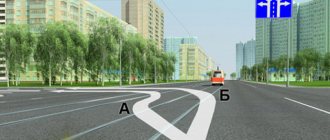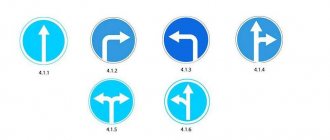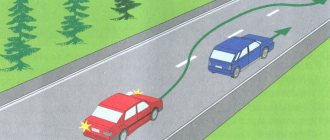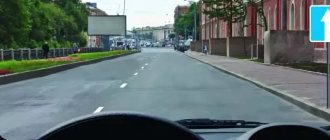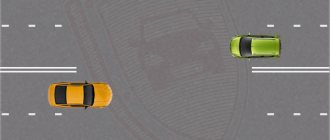What trajectory can you continue moving along?
| 1. | For any reason. |
| 2. | Only according to A. |
| 3. | Only by A or B. |
At this intersection there is a sign “Exit to a one-way road”, which does not prohibit movement straight and to the right. When turning, you should move as close as possible to the right edge of the roadway. Consequently, movement at the intersection can only continue along trajectories A and B.
Driver actions before turning
Before starting to make a U-turn at a one-way intersection, the driver must complete a number of preparatory measures.
- firstly, take the extreme right position in your lane of the roadway, closer to the side of the road, immediately before the start of the intersection.
- Secondly. turn on your turn signal to warn other drivers of your intentions
- thirdly, make sure that the start of the maneuver will not interfere with passing traffic
- mark the starting point for the turn
- start the maneuver.
What signs allow you to make a U-turn?
| 1. | Only A. |
| 2. | B and V. |
| 3. | All. |
Sign 3.18.2 “Left turn prohibited” (A) prohibits only a turn, but not a U-turn. Sign 5.7.2 “Exit onto a one-way road” (B) and sign 5.13.2 “Exit onto a road with a lane for route vehicles” (B) also do not prohibit turning around at the intersections of such roads.
One Way. Part 1. One-way road.
Good afternoon, dear readers.
With this article I want to start a new series, which will be dedicated to one-way roads
I decided to pay attention to them, since over the past few months news has often appeared about the transfer of the center of Moscow to one-way traffic. Moreover, Moscow is not the first city to suffer such a fate.
I have been to other cities where most of the roads are one-way.
Due to the presence of a large number of one-way roads, it became necessary to understand the rules associated with such roads. This is what we will be doing in the new series of articles “One-way traffic”.
So, the topic of our article today is “One-way road”, and we will look at what differences a one-way road has from other roads.
Entrance to a one-way road
5.5 “One-way road.” A road or carriageway along which the movement of motor vehicles over its entire width is carried out in one direction.
This sign should mark the beginning of any one-way road. The sign is also installed at road intersections, one of which is one-way. This is done so that drivers entering the road again can understand that it is one-way and apply the necessary traffic rules.
Entering a one-way road from another road
5.7.1, 5.7.2 “Entering a one-way road.” Entering a one-way road or carriageway.
Such a sign is installed at an intersection if the road being crossed has one-way traffic. The direction of the arrow shows in which direction the road is moving. Accordingly, it is allowed to turn in the direction of the arrow, and prohibited in the opposite direction.
End of a one way road
This sign is installed on a one-way road and marks the end of such a road. It is installed so that drivers do not get carried away by driving on the left side of the road, because oncoming cars can also drive in these lanes. Usually, along with the end of a one-way road sign, a two-way traffic sign is also installed.
One-way traffic "on the other side"
At the entrance to a road with traffic, a no entry sign is installed on the reverse side, which, of course, prohibits entry onto the road. Obviously, failure to comply with this road sign will most likely lead to an accident.
Good luck on the roads!
pddmaster.ru
What signs allow a U-turn?
| 1. | A and B. |
| 2. | Only A. |
| 3. | All. |
Answer
| Sign A “Move to the left” allows for a U-turn, because Mandatory signs permitting left turns also permit U-turns. |
| Sign B “No left turn” prohibits a left turn, but not a U-turn. |
| Sign B “Entering a one-way road” does not prohibit turning. |
The correct answer is Everything.
Turning around at an intersection if there is a pedestrian crossing
Condition: the intersection is located behind a pedestrian crossing. Your actions? Everything is very simple: turning around is prohibited only at a pedestrian crossing, the boundaries of which are determined by markings. If it is absent (there is only a sign), then it means nothing. A pedestrian crossing is also a “crossing in Africa” (even without borders). You are obliged to let pedestrians pass and make your maneuver just beyond the crossing, since, in principle, the traffic rules allow a U-turn at a one-way intersection. You just have to wait a little and move forward. Then you won’t be afraid of any fine.
What signs allow you to make a left turn?
| 1. | A and B. |
| 2. | B and V. |
| 3. | Only B. |
Answer
| You are allowed to turn left by a dead end sign (B), informing you that this road does not have a through passage. |
| You are allowed to turn left by sign B “Exit onto a road with a lane for fixed-route vehicles,” indicating that on the left lane, towards the main flow of vehicles, there is oncoming traffic of buses and (or) trolleybuses. |
| Sign A “Exit onto a one-way road” allows traffic at the intersection only to the right or straight, although it also allows for a U-turn in the opposite direction, but not a left turn towards oncoming traffic. |
The correct answer is B and C.
Which lane should I take after the turn?
8.6. The turn must be carried out in such a way that when leaving the intersection of roadways the vehicle does not end up on the side of oncoming traffic.
After making a left turn, the driver can choose to move in any passing lane ; the rules do not impose any restrictions.
As a rule, drivers choose the left lane to drive in order to avoid crossing with oncoming cars turning right. However, this is not necessary. You can let oncoming cars pass and even turn into the right lane.
Note. Don't forget that when turning right, different rules apply. You must move as close to the right edge of the roadway as possible. That is, you cannot select any band.
Traffic rules are an integral part of the life of every motorist. Drivers have to store a lot of information in their heads in order not to violate traffic rules, but violations still occur. And, as a rule, most violations are associated with incorrect execution of maneuvers. Only one such maneuver will be covered today, but it can cause a lot of trouble if performed incorrectly. Therefore, the topic of the article is “Traffic rules for turning left.”
In what directions are you allowed to move?
| 1. | Just straight ahead. |
| 2. | Only to the right. |
| 3. | Straight or right. |
In this situation, the traffic controller does not change the existing traffic organization at the intersection. The traffic controller's signal and the road sign "Entering a one-way road" allow you to drive through the intersection only straight or to the right.
Driving under the one-way traffic sign
From symbol 5.5 you are allowed to move in the direction indicated by the arrow. A U-turn is prohibited here, because it involves changing the trajectory to the opposite one. Otherwise the rules are simple:
- you need to follow straight ahead in the same way as before, that is, without changing direction until the sign 5.6 or 1.21;
- if necessary, turn left should be done from the far left lane;
- if you need to go to the right, they also first stand in the extreme right position and after performing the maneuver try to maintain it.
Watch this video about the rules for driving on a one-way road:
In what directions are you allowed to move?
| 1. | Just straight ahead. |
| 2. | Just straight and to the right. |
| 3. | Only straight, left and in the opposite direction. |
| 4. | In any. |
In this situation, the traffic controller does not change the existing traffic organization at the intersection. If you are in the right lane, you can only drive straight through the intersection, as the sign “Entering a one-way road” prohibits turning right. To make a left turn or U-turn, you had to take the left lane.
Turning at a one-way intersection from right to left
Another situation. You are moving along a roadway with markings. You are rapidly approaching a road intersection. You intend to make a U-turn (at a one-way intersection). At the exit there is a sign 5.7.2. It reminds the driver that he is entering a road with an OA and that the traffic flow is moving from right to left. In addition, the sign also provides some information. Namely, that you have every right to turn left. Therefore, in order for a U-turn at a one-way intersection on the left to be made correctly, you need to take the left lane and complete it safely.
Reference! If you are in the right lane, you will have to proceed straight through the intersection, as there is no sign allowing you to make a right turn.
Which trajectory do the Rules allow you to make a left turn?
| 1. | Only according to A. |
| 2. | Only according to B. |
| 3. | For any reason. |
The “Exit to a one-way road” sign informs that on the roadway being crossed, traffic is carried out not only in the right, but also in the left lane. Therefore, you can turn left along either of the two paths.
Turning at a one-way intersection from left to right
You are moving along the road. There is an intersection on your route, in front of which there is a sign 5.7.1, informing you that you are entering the road with an OA and that vehicles are moving in the direction from left to right. In addition, you are allowed to turn right. Then it all depends on what lane you are in:
- If on the left, then you can only follow the intersection straight ahead.
- If it's on the right, you can either make a U-turn (at a one-way intersection) on the right, or cross it (if the Lane Direction sign allows it).
What trajectory can you use to make a turn?
| 1. | Only according to A. |
| 2. | Only according to B. |
| 3. | For any reason. |
In this case, a U-turn is prohibited only directly at the pedestrian crossing (trajectory B), the boundaries of which, in the absence of markings, are determined by “Pedestrian crossing” signs. At the intersection (trajectory A), a U-turn can be made, since the “Exit onto a one-way road” sign does not prohibit a U-turn.
Stop and reverse
Decree of the Government of the Russian Federation of October 23, 1993 N 1090 ed.
dated 12/04/2018 About the Rules of the Road, together with the Basic Provisions for the admission of vehicles to operation and the responsibilities of officials to ensure road safety The effect of the “One-way traffic” sign implies not only a prohibition to drive towards the prescribed trajectory, or to turn around. Other maneuvers also have their own characteristics:
- Stopping and parking are permitted on the right side of the road or on the side of the road in the absence of prohibitory signs. On the left, this can only be done in a city or village. But if we are talking about trucks weighing more than 3.5 tons, only stopping is permissible. Parking on the left edge of the area, along which everyone goes in one direction, is prohibited for this type of vehicle. Sometimes the section is adjacent to the oncoming row, reserved for buses and minibuses. In this common case, other vehicles cannot stop and park on the left.
- Engaging reverse gear and under symbol 5.5 must be performed in compliance with paragraph 8.12 of the traffic rules:
Reversing on a one-way road is not prohibited, provided that this maneuver is safe for road users and, taking into account the current traffic situation, is caused by an objective need (for example, avoiding an obstacle, parking).
But in accordance with it, it is prohibited where it is impossible to turn around. That is, it seems to be on the road with the designation 5.5. In fact, the maneuver here can be performed when it is unavoidable and there is no danger to others. But it is possible that the right to do this will have to be proven to a traffic police officer.
Watch this video on how to make a U-turn at a one-way intersection:
What signs prohibit turning left?
There are a sufficient number of signs prohibiting this turn for a motorist. You need to know that not all such road signs directly indicate a prohibition; they may also indicate other rules that automatically prohibit turning left.
Signs that indicate that turning left is prohibited by other rules include signs that indicate the permitted direction of movement. These are white arrows on a blue background. If such a sign does not have an arrow indicating the direction of movement to the left, then accordingly you cannot turn left.
A similar situation exists with a sign indicating one-way traffic. If such a sign points to the right, then turning left is prohibited, as you will be entering the oncoming one-way lane.
Another sign prohibiting left turns is a sign that indicates the direction of movement of route vehicles. In this case, the ban applies if such vehicles are moving to the left.
A sign indicating a specific and explicit prohibition on turning left is the “No Left Turn” sign. “No left turn is prohibited” - the sign is quite simple and easy to recognize. It shows a black arrow indicating a left turn, crossed out by a red line.

